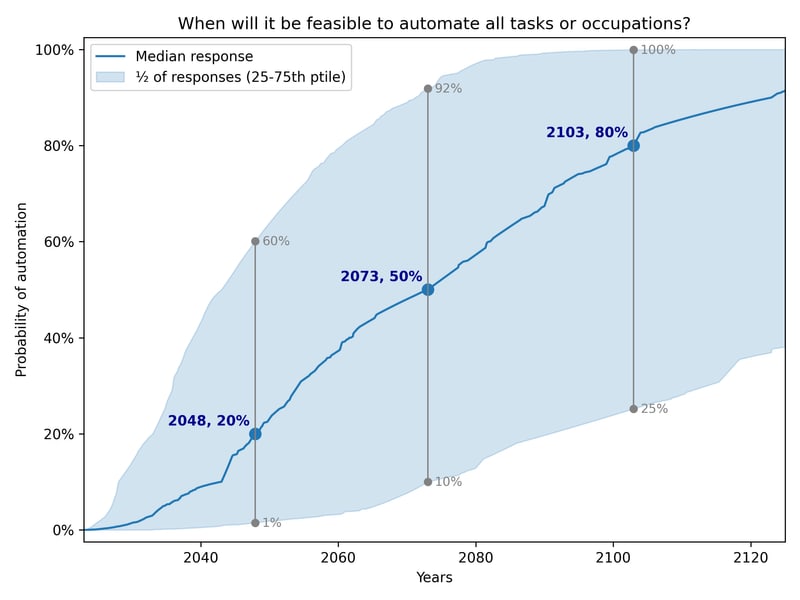Published on January 16, 2025 6:03 PM GMT
This is a linkpost for How should we analyse survey forecasts of AI timelines? by Tom Adamczewski, which was published on 16 December 2024[1]. Below are some quotes from Tom's post, and a bet I would be happy to make with people whose AI timelines are much shorter than those of the median AI expert.
How should we analyse survey forecasts of AI timelines?
The Expert Survey on Progress in AI (ESPAI) is a large survey of AI researchers about the future of AI, conducted in 2016, 2022, and 2023. One main focus of the survey is the timing of progress in AI1.
[...]
This plot represents a summary of my best guesses as to how the ESPAI data should be analysed and presented.
["Experts were asked when it will be feasible to automate all tasks or occupations. The median expert thinks this is 20% likely by 2048, and 80% likely by 2103".]
[...]
I differ from previous authors in four main ways:
- Show distribution of responses. Previous summary plots showed a random subset of responses, rather than quantifying the range of opinion among experts. I show a shaded area representing the central 50% of individual-level CDFs (25th to 75th percentile). MoreAggregate task and occupation questions. Previous analyses only showed task (HLMI) and occupation (FAOL) results separately, whereas I provide a single estimate combining both. By not providing a single headline result, previous approaches made summarization more difficult, and left room for selective interpretations. I find evidence that task automation (HLMI) numbers have been far more widely reported than occupation automation (FAOL). MoreMedian aggregation. I’m quite uncertain as to which method is most appropriate in this context for aggregating the individual distributions into a single distribution. The arithmetic mean of probabilities, used by previous authors, is a reasonable option. I choose the median merely because it has the convenient property that we get the same result whether we take the median in the vertical direction (probabilities) or the horizontal (years). MoreFlexible distributions: I fit individual-level CDF data to “flexible” interpolation-based distributions that can match the input data exactly. The original authors use the Gamma distribution. This change (and distribution fitting in general) makes only a small difference to the aggregate results. More
[...]
If you need a textual description of the results in the plot, I would recommend:
Experts were asked when it will be feasible to automate all tasks or occupations. The median expert thinks this is 20% likely by 2048, and 80% likely by 2103. There was substantial disagreement among experts. For automation by 2048, the middle half of experts assigned it a probability between 1% and a 60% (meaning ¼ assigned it a chance lower than 1%, and ¼ gave a chance higher than 60%). For automation by 2103, the central half of experts forecasts ranged from a 25% chance to a 100% chance.2
This description still contains big simplifications (e.g. using “the median expert thinks” even though no expert directly answered questions about 2048 or 2103). However, it communicates both:
- The uncertainty represented by the aggregated CDF (using the 60% belief interval from 20% to 80%)The range of disagreement among experts (using the central 50% of responses)
In some cases, this may be too much information. I recommend if at all possible that the results should not be reduced to the single number of the year by which experts expect a 50% chance of advanced AI. Instead, emphasise that we have a probability distribution over years by giving two points on the distribution. So if a very concise summary is required, you could use:
Surveyed experts think it’s unlikely (20%) it will become feasible to automate all tasks or occupations by 2048, but it probably will (80%) by 2103.
If even greater simplicity is required, I would urge something like the following, over just using the median year:
AI experts think full automation is most likely to become feasible between 2048 and 2103.
My bet proposal for people with short AI timelines
If, until the end of 2028, Metaculus' question about superintelligent AI:
- Resolves non-ambiguously, I transfer to you 10 k January-2025-$ in the month after that in which the question resolved.Does not resolve, you transfer to me 10 k January-2025-$ in January 2029. As before, I plan to donate my profits to animal welfare organisations.
The nominal amount of the transfer in $ is 10 k times the ratio between the consumer price index for all urban consumers and items in the United States, as reported by the Federal Reserve Economic Data, in the month in which the bet resolved and January 2025.
I think the bet would not change the impact of your donations, which is what matters if you also plan to donate the profits, if:
- Your median date of superintelligent AI as defined by Metaculus was the end of 2028. If you believe the median date is later, the bet will be worse for you.The probability of me paying you if you win was the same as the probability of you paying me if I win. The former will be lower than the latter if you believe the transfer is less likely given superintelligent AI, in which case the bet will be worse for you.The cost-effectiveness of your best donation opportunities in the month the transfer is made is the same whether you win or lose the bet. If you believe it is lower if you win the bet, this will be worse for you.
We can agree on another resolution date such that the bet is good for you accounting for the above.
- ^
There is "20241216" in the source code of the page.
Discuss


